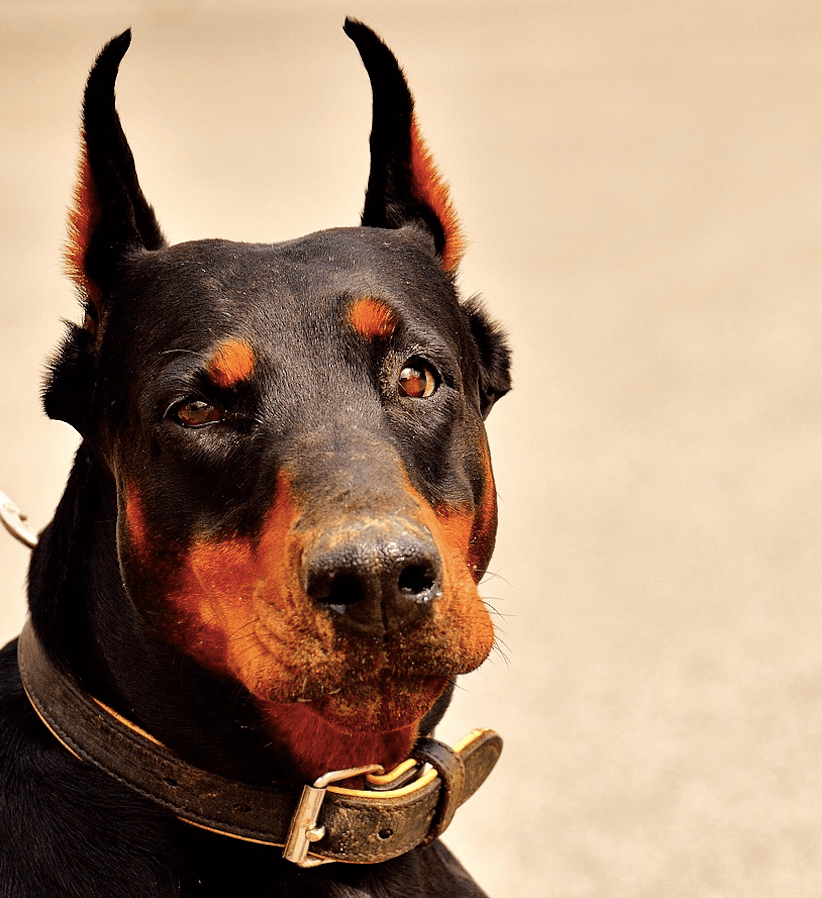Have you ever noticed that some dogs, like Doberman, for example, have these beautifully shaped erect ears? The truth is, – these dogs haven’t been born like that. The shape of their ears is achieved by a veterinary procedure, known as ear cropping in dogs.
In this article, we will talk about the history of ear cropping in dogs, and discuss its general purpose.
We will also consider whether ear cropping in dogs is a cruel practice, and which countries have banned this tradition so far.
What is ear cropping in dogs?
The ear cropping in dogs is the process of removing portions of the ear of an animal. Parts of the ear that are severed include the outer flap of the ear and all of the auricles (pinnae).
The animal’s ears can also be taped so that they’d become pointy when the tape is eventually removed.
Historically, ear cropping in dogs was done for cosmetic and health reasons.
However, in modern times, cosmetic otoplasty (veterinary procedure for cropping) has been banned in several nations because there is less than enough evidence to prove that the animal benefits from it.
However, some countries still practice the ear cropping in dogs, but it is only permitted in a small number of dog breeds.
These dog breeds include:
- Doberman pinscher,
- Beauceron,
- Pit-bull,
- German Pinscher,
- Boxer,
- Schnauzer,
- Great Dane,
- Dogo Argentino,
- Neapolitan Mastiff,
- Cane Corso,
- Caucasian shepherd dog,
- Bouvier des Flandres,
- Central Asian shepherd dog.
Ear cropping in canines is a process that is closely related to tail docking because they both involve the severance of a portion of the dog’s body to meet a certain standard.
History of Ear Cropping In Dogs
If we had a time machine, we would travel back several centuries until we find ourselves in ancient Rome. That is the place where the tradition of ear cropping in dogs began.
The procedure of severing a portion of a dog’s ears is several centuries old, starting from the 6th or 7th century.
At that time, the common belief was that ear cropping safeguards the dog’s health from dangerous complications like haematomas and ear infection.
Hunting dogs, or dogs that were used in fighting or herding animals did also undergo the ear cropping. There were cases when prey or livestock predators could fight back, grab the dog’s ears and tear it apart. This, in turn, might have lead to ear injuries and infection.
Dog breeds like the Pastore Maremmano-Abruzzese and the Caucasian shepherds that were mostly used in hunting were cropped because it was thought that wolves or other powerful game might grab their ears in a fight.
The process of ear cropping in dogs involved twisting and dragging a puppy’s ear until that portion fell off. This cruel process, however, made such puppies not to have any external ear left.
Another technique was the use of very sharp shears to cut off a part of the puppy’s ears. Sometimes the ears are cut to look rounded like those of a bear or pointy like those of a fox.
Cropping was also done by expert shepherds back in the days and often in the 6th week of the dog’s life.
Why Were Dog’s Ears Cropped?
In ancient times, and till the present day in countries where cropping is still legal, the act was done for two primary motives: health and cosmetic reasons.
Health Purposes
Some dogs’ ears seemed to hang down their heads, and croppers believed that these dogs suffered or were at a higher risk of suffering ear infection than those whose pinnae had been chopped off.
Furthermore, ear injuries that might lead to serious medical issues were avoided (or so it seemed) by the process of ear cropping.
Also, in dog breeds like boxers, cropping was believed to improve their hearing as the sound was directed into their eardrum, making it louder and clearer than when they had hanging ears.
Sound waves were also believed to be restricted because of outer ears that hungover and covered the ear canal.
Cosmetic Purposes
Despite the act of ear cropping in dogs being banned in several countries worldwide, some nations haven’t placed any restrictions on it. They still carry on the process to meet a breed standard, especially for dogs participating in shows or exhibitions.
This has been going on dating from the last century to date.
Cosmetic otoplasty, as veterinarians call this process, is not taught in schools, especially in countries where the act is banned.
Most veterinarians learn the art on the job. If an amateur is allowed to perform this process, there might be issues with the dog’s ear much later in its life.
In countries like the United States, ear cropping has been on the decline, except for the show dogs.
Most owners of these show dogs claim that if they stood a chance of not being sanctioned and winning a show for not ear cropping their dogs, they wouldn’t hesitate to quit the act.
How And When Is Ear Cropping In Dogs Done?
Cosmetic otoplasty is carried out on dogs when they are at least six weeks of age. The most it can be delayed is 12 weeks.
It is because dogs of 15-16 weeks tend to have stronger memories of whatever caused them pain. Plus at this age, the process would be less bearable for the pup.
The painful process was done without any anesthesia back in time, but the latter is recommended nowadays.
After chopping off about 2/3 of the canine’s outer ear, the injured edges the veterinarian then fixes it with stitches.
Bandages or tapes are then used to guide the ears to have a particular shape – the shape they would have when they must have been completely healed.
What Is the World’s Legal Standing on Ear Cropping In Dogs?

In most parts of Europe, ear cropping is illegal. All the nations that are members of the ECCPA (European Convention for protection of Pet Animals) body have likewise banned the act.
However, Italy, after a 2007 decree against the act, still sits on the fence. In some provinces in Canada and Spain, ear cropping is illegal.
All in all, statistics show that around 130,000 pups are cropped annually in the United States.
Despite this fact, the AKC (American Kennel Club) and CKC (Canadian Kennel Club) have stood against most countries’ decision to ban ear cropping is some dogs’ breeds.
Namely, they cited health factors and breed standards to be the reason for their continuous endorsement and support for the process.
On the other side, he AVMA (American veterinary medical association) and the AHA (American humane association) have come out strongly to oppose ear cropping in dogs, especially for cosmetic purposes or breed standards.
They also insisted that if ear cropping must be done, it must be due to health purposes and directed by a licensed veterinarian.
With that said, we are going to see which countries have banned ear cropping and which haven’t. We are also going to see which countries blow hot and cold on the idea.
In Which Countries Is Ear Cropping In Dogs Banned?
Here is a list of the countries that have condemned the act of ear cropping in dogs and where it is illegal:
- Austria
- Australia
- Belgium
- Bulgaria
- Croatia
- Cyprus
- Denmark
- Estonia
- England
- Finland
- France
- Germany
- Greece
- Hungary
- Israel
- Iceland
- Ireland
- Lithuania
- Latvia
- Netherland
- Luxembourg
- Northern Ireland
- New Zealand
- Norway
- Portugal
- Poland
- Romania
- Scotland
- South Africa
- Slovenia
- Slovakia
- Sweden
- Switzerland
- Turkey
- Virgin island and
- Wales
In Which Countries Is Ear Cropping In Dogs Legal?
Here is another list of countries that haven’t banned the act. It means it is carried out in some parts and for specific reasons.
- Canada
- Brazil
- Columbia
- Russia and
- Spain
In the list below, ear cropping in dogs is entirely unrestricted:
- Argentina
- Afghanistan
- Bolivia
- Chile
- Costa Rica
- Egypt
- India
- Indonesia
- Kuwait
- Lebanon
- Malaysia
- Mauritius
- Morocco
- Mexico
- Nepal
- Panama
- Peru
- Philippines
- Taiwan
- Sri Lanka and
- United States
Is It Cruel To Crop a Dog’s Ears?

As a person with self-respect, you wouldn’t subject yourself to excruciating pain for cosmetic reasons. Or, at least, there would be some anaesthetic involved. Dogs? They haven’t been that lucky except for maybe recent times.
The way we see it, – the act of cropping in dogs is disfiguring, cruel, and unscrupulous.
The act doesn’t just cause dogs physical pain, but also vast psychological distress. In other words, the ear cropping in dogs traumatises and affects the puppy psychologically. This trauma tends to have a significant effect as it matures, a new study confirms.
Think also of the procedures in taping and re-taping the canine’s ears so that they will be erect and grow that way – another agonizing endure for the animal.
Moreover, ears are a way by which dogs communicate their feelings with owners. Therefore, removal of the ears can impact the flow of communication from the dog to the owner or other humans.
Point often overlooked is that this process of communication goes both ways. Since you won’t be able to understand your dog’s emotions, you will experience your pet’s behaviour like aggressiveness, which can even lead to biting.
Anti-cropping advocates have found out there is no health benefit associated with ear cropping. Breeders perform this procedure solely for unnecessary preservation of breed standard set by the AKC – ultimately for fashion purposes.
As a veterinarian, it is essential to warn the dog owners who want to crop their dog’s ears on the consequences of such cruel practice.
All in all, except under necessity, ear cropping in dogs should be avoided.
Other Forms of Mutilations In Dogs
Ear cropping isn’t the only form of mutilation a dog suffers. It is often performed along with tail docking.
Tail docking is the process of severing a portion of the dog’s tail for almost the same reasons as ear cropping – health and cosmetic purposes.
Pro-docking activists claim that working dogs can be grabbed by their tails by other animals while hunting and hence there is the the need to sever it.
Some also state on the grounds of hygiene that tails may become messy, pick up dirt, and catch an infection, causing other issues for the dog and its owner.
The AKC also backed the ear cropping in dogs on the grounds of protection of breed traits and standard, placing sanctions on any dog owner, whose dog’s ears/tail wasn’t docked or cropped correctly.
Besides, dogs were not allowed to partake in dog shows or ring sports if they were not cropped or docked as need be. The AKC body claimed it needs to preserve every breed standard that was passed on for several generations.
A dog uses its tail for the purpose of communication as much as its ears.
In other words, different motions of a canine’s tail might show irritation, anxiety, fear, or happiness. Hence, cutting off the tail means impeding its ability to show such emotions or communicate it with humans.
Furthermore, most of the time people perform tail docking in dogs without any anaesthesia.
A tail docking includes cutting through the dog’s bone, cartilage, tendons, flesh, and tissues.
Needless to say that it causes excruciating pain and trauma for the dog. There were cases of dogs dying from shock or infected neuromas.
You can read more about tail docking in dogs in our next article.
Conclusion
To sum up, ear cropping doesn’t make a dog’s life easier. Neither does it make any difference to the owner.
It might have been a reasonable procedure during the earlier days when people used dogs for work like hunting, herding, fighting, and more.
However, these days, dogs don’t work as much as they did in the past. They are kept as family pets, and most of them are not “working dogs.”
Therefore, such gruesome practices on canines are now considered inhumane and cruel.
Except for some exceptional health grounds, ear cropping shouldn’t be done on dogs. It has been banned in several nations of the ECPPA and the AHA bodies.




